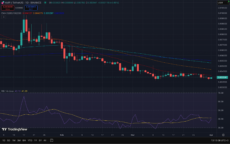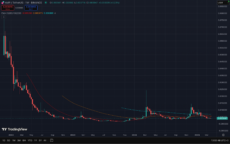The Ethereum Pectra Upgrade marks a major evolution for the network, combining proposals like EIP-7251 and EIP-7702 to streamline ...
AMP Token Price Prediction: Future Outlook and Investment Insights
| Updatedby Tony Frank · 13 mins read

In this article, you’ll get a comprehensive look at what AMP is, why it’s gaining renewed attention, and whether it deserves a place in your portfolio. We’ll explore AMP price predictions from 2025 through 2030.
Amp is a digital collateral token that supports fast, secure, and decentralized transactions across various blockchain-based payment platforms. As the native collateral asset of the Flexa Network, it plays a vital role in ensuring transaction finality and minimizing settlement risk—bringing real-world utility to crypto payments.
In this article, we dive into a detailed Amp coin price prediction, analyzing the token’s current market standing, core functionality, and the key drivers behind its performance. We’ll cover short-, medium-, and long-term forecasts, supported by both technical indicators and fundamental insights, to help evaluate AMP’s potential as a long-term investment in the evolving crypto economy.
What is Amp Token?
Amp is a digital collateral token designed to secure and expedite cryptocurrency transactions. Unlike traditional payment systems that rely on intermediaries and settlement times, AMP provides instant assurance through collateralization, allowing transactions to be confirmed immediately and finalized later.
The current price of AMP is AMP $0.00351 24h volatility: 0.1% Market cap: $295.70 M Vol. 24h: $13.79 M , and its market cap is $333.8 million.

Photo: Official AMP Website
At the core of Amp’s utility is its role in the Flexa Network, a payment platform that enables merchants to accept digital assets without exposing themselves to volatility or settlement risk. When a user initiates a payment with crypto via Flexa, Amp tokens are temporarily locked as collateral until the underlying asset transfer is completed. If the transaction fails or is delayed, the collateral can be liquidated to cover the payment, ensuring merchants receive funds without waiting.
This approach reduces friction in digital payments and addresses a fundamental issue in crypto adoption: speed and certainty. By decoupling transaction security from the underlying blockchain confirmation times, Amp allows payments to be both trustless and instant—two features rarely combined in the crypto space.
Amp’s design as a universal collateral system means it’s not limited to Flexa. It can be integrated into any application where value transfer requires assurance—potentially expanding its impact beyond digital commerce.
Current AMP Cryptocurrency Sentiment
Since its launch, AMP has undergone multiple distinct market phases, shaped by broader crypto cycles and changing investor behavior. Reviewing its price history, major exchange listings, and current market metrics offers valuable context for assessing the token’s long-term outlook—especially when considering current AMP sentiment and prevailing trends in the digital asset space.
Historical Price Movements
AMP was listed on Binance in late 2021, marking a significant milestone for the token’s visibility and liquidity. However, AMP reached an all-time high of approximately $0.1208 in January 2021.

AMP Price Chart. Source: TradingView
AMP Today Circulating Supply, Market Cap
As of April 2025, Amp Token (AMP) has a circulating supply of 84,231,346,590 AMP out of a maximum supply of 99,669,205,039 AMP.
The trading price is around $0.003953, with a 24-hour trading volume of approximately $9.8 million and a market cap near $333.8 million.
Amp Crypto Technical Analysis
Technical indicators offer a data-driven lens to assess the current state of AMP’s price action. Over the past several months, AMP has traded in a relatively narrow range, with declining volatility and reduced trading volume suggesting consolidation rather than strong directional momentum.
The 50-day moving average (MA50) has hovered below the 200-day moving average (MA200)—a classic bearish signal—indicating that AMP remains in a longer-term downtrend. A crossover above the 200-day line would be seen as a potential shift in market structure, but this has yet to materialize.

AMP Latest Data. Source: TradingView
Meanwhile, the Relative Strength Index (RSI) has fluctuated between 35 and 55, staying mostly neutral but occasionally dipping near oversold territory (below 30), hinting at potential accumulation zones. However, there’s been no sustained bullish divergence to indicate a reversal.
Key support levels appear near the $0.0035–$0.0038 range, where historical buying interest has previously stepped in. Resistance is seen closer to $0.0050 and $0.0062—levels that have rejected upward moves multiple times in recent months.
Regarding sentiment, AMP is currently in a wait-and-see phase, with traders watching for either a catalyst to break above resistance or a further drop toward lower support. Until broader adoption of the Flexa network accelerates or macro market conditions improve, AMP is likely to remain range-bound.
Fundamental Analysis of Amp
Amp positions itself as a foundational layer for digital collateral, aiming to bring speed and security to crypto payments without compromising decentralization. Its primary use case is within the Flexa Network, where it collateralizes transactions in real time, allowing merchants to accept crypto payments with zero risk of failed settlements. This mechanism bridges a critical gap in mainstream adoption by making digital payments as seamless and reliable as traditional systems.
The project is backed by Flexa, a company with a clear strategic vision and a growing network of partnerships in the payments space. Flexa has integrated with major retail chains and payment gateways, reinforcing AMP’s relevance as a utility token rather than a purely speculative asset. These integrations are key to long-term sustainability, tying Amp’s value directly to usage rather than hype.
From a broader perspective, AMP’s success is tied to two major trends: the growth of the digital payments sector and the adoption of crypto as a medium of exchange. As more retailers experiment with accepting digital assets and stablecoins, infrastructure tokens like AMP could gain traction—especially if regulatory clarity accelerates institutional interest.
However, AMP also faces headwinds. The overall slowdown in DeFi adoption, bearish macro conditions, and intense competition from Layer-2 scaling solutions may limit short-term momentum. Yet, if Flexa continues expanding its footprint and real-world usage grows, Amp could become a cornerstone in the evolving crypto payment stack.
Short-Term Amp Price Predictions (2025)
As the crypto market continues its gradual recovery in 2025, AMP remains a speculative but structurally significant token for those tracking real-world adoption in the payments sector. While major bullish catalysts—such as institutional adoption of Flexa or regulatory green lights for crypto payments—are still unfolding, analysts project a cautiously optimistic price range for AMP this year.
Based on technical indicators, macroeconomic trends, and network usage metrics, the following table outlines a range of short-term forecasts for AMP in 2025:
| Month | Minimum Price | Average Price | Maximum Price | Potential ROI |
| Apr 2025 | $ 0.004158 | $ 0.004466 | $ 0.004719 | 19.59% |
| May 2025 | $ 0.004179 | $ 0.004526 | $ 0.005162 | 30.81% |
| Jun 2025 | $ 0.004248 | $ 0.004429 | $ 0.004683 | 18.67% |
| Jul 2025 | $ 0.004503 | $ 0.004562 | $ 0.004749 | 20.35% |
| Aug 2025 | $ 0.004298 | $ 0.004401 | $ 0.004514 | 14.40% |
| Sep 2025 | $ 0.004304 | $ 0.004357 | $ 0.004425 | 12.15% |
| Oct 2025 | $ 0.004331 | $ 0.004478 | $ 0.004615 | 16.95% |
| Nov 2025 | $ 0.004348 | $ 0.004415 | $ 0.004578 | 16.03% |
| Dec 2025 | $ 0.004373 | $ 0.004381 | $ 0.004389 | 11.23% |
Medium-Term Amp Coin Price Prediction (2026)
Looking ahead to 2026, AMP’s price outlook hinges on whether it can transition from a niche collateral token to a widely adopted infrastructure asset in the digital payments ecosystem. While the token’s fundamentals are closely tied to the success of the Flexa Network, its broader valuation will likely reflect the overall health of the crypto market and evolving trends in payment technology.
If adoption momentum continues and macroeconomic conditions stabilize, AMP could see a gradual revaluation driven by utility rather than speculation. Below is a medium-term projection based on current trends and potential market scenarios:
| Month | Minimum Price | Average Price | Maximum Price | Potential ROI |
| Jan 2026 | $ 0.004075 | $ 0.004226 | $ 0.0044 | 11.49% |
| Feb 2026 | $ 0.004038 | $ 0.004105 | $ 0.004143 | 5.00% |
| Mar 2026 | $ 0.004034 | $ 0.004059 | $ 0.004094 | 3.76% |
| Apr 2026 | $ 0.003968 | $ 0.004021 | $ 0.004085 | 3.53% |
| May 2026 | $ 0.003853 | $ 0.003894 | $ 0.00396 | 0.35% |
| Jun 2026 | $ 0.003815 | $ 0.003835 | $ 0.003864 | 2.08% |
| Jul 2026 | $ 0.003812 | $ 0.003822 | $ 0.003831 | 2.93% |
| Aug 2026 | $ 0.003783 | $ 0.003802 | $ 0.003817 | 3.27% |
| Sep 2026 | $ 0.003763 | $ 0.003772 | $ 0.003787 | 4.04% |
| Oct 2026 | $ 0.003763 | $ 0.003764 | $ 0.003767 | 4.54% |
| Nov 2026 | $ 0.003743 | $ 0.003751 | $ 0.003766 | 4.56% |
| Dec 2026 | $ 0.003739 | $ 0.003742 | $ 0.003745 | 5.09% |
Long-Term AMP Price Prediction (2030)
By 2030, the AMP market is projected to reflect the long-term realization of the project’s vision—positioning itself as a universal, decentralized solution for collateral models in global payments. Built to ensure instant and secure value transfer, AMP stands at the intersection of crypto utility and real-world adoption. If the Flexa Network continues to expand and decentralized payment systems gain institutional support, AMP may evolve from a microcap token into a core infrastructure asset powering real-time settlement layers.
In such a future, the current price of AMP—hovering around $0.0039—could appear deeply undervalued. Analysts offering an AMP forecast for 2030 suggest a wide range of possibilities, with the token potentially reaching a maximum value of $0.10 to $0.15 in optimistic scenarios. Even more conservative models expect steady growth tied to merchant integration and rising transaction volumes, resulting in a significantly higher average trading value than today.
The outlook also assumes ongoing regulatory clarity, advances in payment infrastructure, and wider adoption of decentralized collateral models beyond Flexa. If these factors align, AMP could decouple from short-term speculation and begin tracking usage metrics and protocol-level demand more closely.
Ultimately, AMP’s future depends not just on crypto market cycles but on whether it can fulfill its foundational purpose: becoming a seamless, programmable collateral layer that underpins a new era of borderless, blockchain-native commerce.
Below is a forecast table illustrating possible price scenarios for AMP by 2030:
| Month | Minimum Price | Average Price | Maximum Price | Potential ROI |
| Jan 2030 | $ 0.004165 | $ 0.005643 | $ 0.007742 | 96.19% |
| Feb 2030 | $ 0.00376 | $ 0.004478 | $ 0.00492 | 24.69% |
| Mar 2030 | $ 0.003714 | $ 0.003977 | $ 0.004212 | 6.73% |
| Apr 2030 | $ 0.002849 | $ 0.003487 | $ 0.004281 | 8.48% |
| May 2030 | $ 0.001727 | $ 0.002106 | $ 0.002822 | 28.49% |
| Jun 2030 | $ 0.0013 | $ 0.001494 | $ 0.001767 | 55.23% |
| Jul 2030 | $ 0.00126 | $ 0.001366 | $ 0.001445 | 63.37% |
| Aug 2030 | $ 0.000916 | $ 0.001138 | $ 0.001276 | 67.66% |
| Sep 2030 | $ 0.000726 | $ 0.000814 | $ 0.000992 | 74.86% |
| Oct 2030 | $ 0.000727 | $ 0.000745 | $ 0.000772 | 80.43% |
| Nov 2030 | $ 0.000515 | $ 0.000582 | $ 0.000767 | 80.57% |
| Dec 2030 | $ 0.000464 | $ 0.000497 | $ 0.000533 | 86.48% |
AMP Prediction Price from Crypto Analysts
Crypto analysts have provided various forecasts for AMP’s price trajectory in the coming years:
- 2025 Forecasts: Analysts anticipate that AMP could reach a maximum price of $0.02702 by 2025, with a minimum expected price of around $0.01610. This projection is based on broader market recovery and increased adoption of the decentralized finance (DeFi) platform.
- 2030 Forecasts: Looking further ahead, projections suggest that AMP’s price could rise significantly, potentially reaching up to $0.6858 by 2030. This optimistic scenario assumes the widespread adoption of AMP’s technology and integration into global digital payment systems.
These projections are contingent upon several factors, including the overall growth of the crypto market, regulatory developments, and AMP’s ability to establish strategic partnerships and expand its use cases within the digital payments ecosystem.
What Affects AMP Token Price Chart?
Like most digital assets, the AMP cryptocurrency is influenced by market dynamics, technical signals, and ecosystem developments. One of the core drivers is its integration into the Flexa Network, where AMP acts as collateral to secure transactions and improve both transaction efficiency and transaction speed. As adoption of Flexa grows—particularly across sectors like property sales and loan distribution—demand for AMP could see significant growth, directly impacting its average trading price.
According to the latest AMP price prediction, analysts suggest that wider implementation of collateral partitions and predefined partition strategies could improve AMP’s utility across various payment channels, reinforcing its role in decentralized finance. These developments and Flexa’s expansion into new markets add weight to bullish outlooks over the coming years.
From a technical standpoint, the relative strength index (RSI) has become a key metric in gauging current price momentum. AMP has recently hovered near key RSI levels, suggesting neutral-to-bearish market sentiment, although shifts in the greed index could signal an approaching trend reversal. In parallel, technical analysis highlights critical resistance levels around previous local highs, which AMP would need to break to establish a sustainable uptrend.
Additionally, broader market analysis points to macroeconomic pressures, regulatory changes, and major listings—like its 2021 debut on Binance—as major catalysts for short-term volatility. Tokenomics also matter: with a large portion of AMP already circulating, staking behaviors and supply unlocks continue to influence liquidity and long-term value perception.
While AMP’s foundation as a real-world collateral solution is solid, the token’s price remains subject to broader speculative forces. For investors, tracking technical indicators and real-world integrations will be essential in evaluating future performance.
How to Buy and Stake Amp Tokens: FAQ
For investors interested in adding AMP to their portfolio, purchasing and staking the token is relatively straightforward. AMP is supported on several major platforms, and its integration with the Flexa Network allows for direct utility beyond simple trading.
Where to Buy AMP
AMP is available on a range of centralized and decentralized exchanges. Some of the most commonly used platforms include:
Before purchasing, users will need a crypto wallet that supports ERC-20 tokens (e.g., MetaMask or Coinbase Wallet).
Quick Guide: How to Buy AMP
- Choose an exchange that lists AMP and create an account.
- Deposit funds (USD, EUR, or crypto like BTC/ETH).
- Search for AMP in the trading interface and place a buy order.
- Transfer AMP to your personal wallet for custody or staking.
How to Stake AMP
AMP is primarily staked via the Flexa Capacity portal. By staking AMP, users help secure transactions on the Flexa Network and earn a share of transaction fees.
Steps to stake AMP:
- Go to the official Flexa Capacity platform.
- Connect a supported wallet (e.g., MetaMask).
- Choose a merchant app pool to stake into.
- Enter the amount of AMP you want to stake and confirm the transaction.
- Begin earning rewards, which are typically distributed in proportion to your stake size and network activity.
Potential Rewards
Staking yields vary based on network usage, but returns are generally paid in AMP. Rewards are not fixed and depend on the transaction volume processed by the pools you’re staked into.
While AMP staking offers a passive income opportunity, users should be aware of network risks, Ethereum gas fees, and potential opportunity costs associated with locking tokens.
Conclusion
The Amp project offers a distinctive approach within the crypto space, positioning itself as a digital collateral solution that prioritizes speed, security, and real-world reliability. Unlike many speculative tokens, AMP derives value from its integration into the Flexa Network, where it plays a functional role in enabling instant, risk-free transactions for merchants and users alike.
AMP is expected to benefit from the broader adoption of decentralized payment systems and collateral-backed settlement models. Analysts point to the potential for a bullish trend in the coming years, especially if the project continues to secure new partnerships and expands Flexa’s merchant ecosystem. In some long-term forecasts, AMP could reach as high as $0.15 by 2030—though this scenario assumes favorable market conditions and sustained technological relevance.
Market performance to date has shown intermittent momentum, with AMP recording several clusters of green days that suggest renewed interest during periods of ecosystem development or positive news cycles. However, as with any early-stage protocol, volatility remains high, and price action can quickly reverse without warning.
Despite the risks, the underlying fundamentals of the Amp project point to real utility—a key differentiator in a crowded and often speculative market. For investors, AMP may appeal as a strategic long-term bet on the infrastructure layer of crypto payments, especially as demand grows for fast, secure, and decentralized transaction settlements.
As always, navigating this space requires a balanced perspective. While Amp is expected to benefit from macro trends and network adoption, staying informed, managing risk, and adapting to rapid market shifts remain essential to any investment strategy.
Disclaimer: This article is for informational purposes only and does not provide financial, trading, or investment advice. Cryptocurrency prices can fluctuate wildly, and actual values may differ from AMP predictions.
Always do your own research (DYOR), assess risks, and consult a professional before making financial decisions. The author and team are not responsible for any losses from using this information.
FAQ
How does AMP compare to other payment-focused cryptos?
AMP stands out as an instant collateralization feature powered by the Flexa network. Furthermore, it offers faster and more secure transactions than other crypto solutions like Bitcoin and Litecoin. However, it also faces competition from stablecoins, DeFi tokens, and traditional market competitors.
What is the current Amp price?
As of April 2025, Amp is trading at approximately $0.0039, though prices may vary slightly depending on the exchange.
Is Amp a good investment?
Amp has long-term potential due to its real-world utility, but like all crypto assets, it remains a high-risk investment with significant volatility.
What are the key factors affecting Amp's price?
Amp’s price is influenced by adopting the Flexa Network, overall market sentiment, token utility, and broader crypto trends.
How can I buy Amp tokens?
You can purchase Amp on major exchanges like Binance, Coinbase, or Uniswap by funding your account and placing a market or limit order.
What is the Amp price prediction for 2025?
Forecasts for 2025 suggest a price range between $0.006 and $0.015, depending on market conditions and Flexa adoption.
What is the Amp price forecast for 2030?
By 2030, AMP could reach $0.10–$0.15 in a bullish scenario, assuming widespread integration and increased demand for collateralized payments.
How does staking Amp tokens work?
You can stake AMP through the Flexa Capacity platform to support transaction collateralization and earn rewards based on network usage.
What is the Amp network and its significance?
Amp is a collateral protocol that enables fast and secure crypto transactions by locking AMP tokens until transfers are confirmed, making real-time payments possible.
How does the crypto market influence Amp's price?
Like most altcoins, AMP’s price tends to follow broader market trends, especially Bitcoin and Ethereum movements.
What are the risks associated with investing in Amp?
Risks include price volatility, uncertain regulatory developments, competition from other protocols, and limited liquidity during market downturns.
How does AMP ensure secure instant transactions?
AMP collateralizes transactions in real-time, allowing merchants to accept crypto payments instantly while reducing settlement risk.
Can AMP be used outside of the Flexa Network?
AMP is designed to be a universal collateral token and can be integrated into other platforms requiring secure value transfer.
Why has the price of AMP been so volatile?
AMP’s price reflects speculative trading, low liquidity at times, and sensitivity to both market news and network adoption levels.
What’s the utility of AMP in the DeFi ecosystem?
AMP can be used as decentralized collateral in DeFi protocols, offering a layer of security for value transfer and asset bridging.
Does AMP have a limited maximum supply?
Yes, AMP has a capped maximum supply of 99,669,205,039 tokens.
Is AMP inflationary or deflationary?
AMP is non-inflationary by design, with a fixed supply, though staking rewards and network usage determine token flow.
How is AMP different from other collateral tokens like RSR or MKR?
Unlike RSR or MKR, AMP is chain-agnostic and focused solely on instant, collateralized payments rather than stablecoin backing or governance.
Does AMP support multi-chain or cross-chain integrations?
AMP is based on Ethereum, but the protocol’s design allows for future multi-chain or cross-chain expansion.
What is the governance model of the AMP network?
Currently, AMP does not have a formal decentralized governance model like DAOs; governance decisions are primarily driven by its core development team.
Are there AMP liquidity pools on DEXs like Uniswap?
AMP is available in liquidity pools on decentralized exchanges such as Uniswap and SushiSwap for trading and yield farming.
Solana is one of the most technically advanced Layer 1 blockchains, offering high-speed transactions, low fees, and a fast-growing...
Pi Network is pioneering a mobile-native approach to cryptocurrency mining, offering an accessible alternative to energy-intensiv...